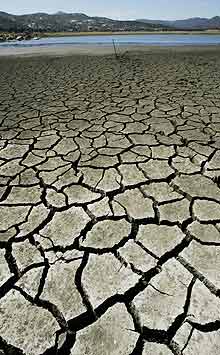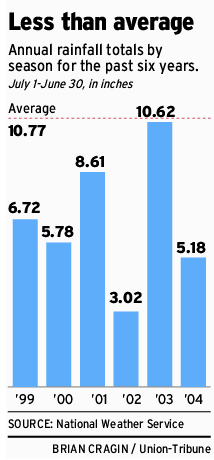Experts say dearth of rain in Western states 'historic'
2004 07 05
 By Luis Monteagudo Jr. By Luis Monteagudo Jr.
Lakes are drying up, water districts are ramping up conservation efforts and farmers are searching the skies in vain for drops of rain.
As the official rain season ends today, San Diego County is in the grip of a drought that is being felt throughout the Western United States.
Some experts are saying this could be the worst drought in 500 years.
"We're in a drought perhaps as deep as the Dust Bowl" of the 1930s, said William Patzert, a researcher at the Jet Propulsion Laboratory in Pasadena, which is run by the California Institute of Technology for NASA.
Water district officials say there's enough water to meet demand for at least a couple of more years. But no one, not even the experts, knows how long the dry spell will last.
"The bottom line is we are dry and it is a historic drought," said Douglas Le Comte, a senior meteorologist and drought specialist for the federal Climate Prediction Center.
How dry are we? This dry:
Through Friday, the county has had 5.18 inches of rain for the season, as measured by the National Weather Service at Lindbergh Field. That's less than half the average rainfall of 10.77 inches from a period of July 1 the previous year to June 30.
And the region has been below its average rainfall amount for the past five seasons.
"That's what's called a drought," Patzert said.
Several lakes and reservoirs in the county are below their water levels, ranging from 7.7 percent full at Lake Sutherland, near Ramona, to 84.7 percent full at San Vicente Reservoir in Lakeside.
 San Diego and the Southern California region are not alone. Eight Western states have been suffering through periods of drought or extreme drought. San Diego and the Southern California region are not alone. Eight Western states have been suffering through periods of drought or extreme drought.
A U.S. Geological Survey report released this month said that based on water levels of the Colorado River basin, the drought "may be comparable to or more severe than the largest-known drought in 500 years."
The flow at a spot along the Colorado River traditionally used for measurements has been an average of 5.4 million acre-feet from 2001 to 2003. During the Dust Bowl years of 1930 to 1937, it averaged 10.2 million acre-feet.
Experts say the drought started in late 1999 or 2000. Several factors are believed to have caused it, including a large high pressure system that has kept a jet stream north of the Western states, preventing rain and moisture from the area.
Although scientists have studied droughts, knowledge is still so limited that long-range forecasts are not made for droughts.
The longest forecast is that much of California and other Western states will have drought conditions through September. Beyond that, experts say they don't know how long it could last. However, droughts seldom persist for longer than a decade.
"(There are) a lot of theories about climate changes and all these things going on," said Bill Jacoby, a water resources manager for the San Diego County Water Authority. "We do know we're at the mercy of nature."
There are indications of a wetter fall and winter because of a mild El Niņo phenomenon. But even that is unclear.
"We just don't see a strong signal one way or the other," Le Comte said.
For California, droughts are not unusual. And water officials say the state and region can handle this dry period because they've prepared for it by building up water reserves and launching strong conservation efforts.
"Right now, there's adequate storage for Southern California's needs for the next couple of years without a problem," said John Liarakos, a spokesman for the county water authority.
The county relies mostly on imported water and uses about 650,000 acre-feet per year. One acre-foot is enough water, on average, to supply two families for a year.
Local and regional water officials have pushed voluntary conservation efforts, such as low-flow toilets and shower heads. In recent weeks, the county water board adopted several conservation methods, including water budgets for commercial users and vouchers for irrigation controllers that can sense the weather and determine whether sprinklers should be turned on.
Despite the adequate supplies, water officials warn that this is no time for consumers and businesses to get complacent about conservation.
"Every drop of water that we save today is a drop of water that we can use for drier times," said Adan Ortega, vice president for external affairs for the Metropolitan Water District of Southern California. "We have enough water today to sustain us for the foreseeable future so long as we continue to pursue conservation."
Northern California's mountains received heavy snowfall during December and February but warm, dry weather hit in March, prompting an early thaw and runoff.
Even with the shift in March, precipitation accumulation in the Northern Sierra Nevada was 96 percent of average. The state relies heavily on the Sierra Nevada snowpack to provide water through the summer.
"The precipitation was much less when you got south of Sacramento," said state climatologist Bill Mork, who works for the state Department of Water Resources.
Mork said the governor has not declared a statewide drought. Overall, he said, the state has enough water in storage to meet the demands of water customers.
The San Diego County Farm Bureau estimated 5,000 farmers rely heavily on conservation to get them through droughts because they have to buy more water during droughts, said Eric Larson, executive director of the bureau.
"They can't afford to have high water bills so the farmers manage their water very, very closely," Larson said.
Larson said the area's farmers are surviving the drought, but praying for more rain.
The drought will end eventually, experts say. Le Comte said his gut instinct is more rain will arrive later this year. But then again, that's not always a good thing.
"You better watch out what you pray for, because California goes from one extreme to the other," he said.
Staff writer Karen Kucher contributed to this report.
Article From: http://www.signonsandiego.com/news/state/2004063...

|
